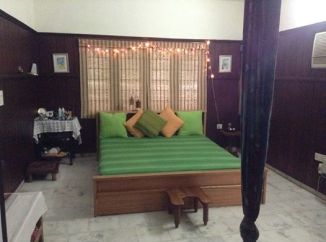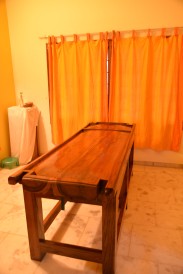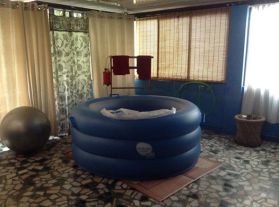
labour/ delivery room, with rope and birthing stool.
I was excited when I searched the net a couple years ago and found Birth village in the south of India near to my in-laws house. I didn’t know much about the state of birth in India but thought it would be interesting to check out how a birth center functions in Kerala, India. After contacting and speaking with the head midwife, my family and i made plans to stay near the center so i can do some research.
As an advocate of natural birth I want to emphasize that I have seen and I know of circumstances that hospital interventions are absolutely necessary and vital. Some women are very comfortable in the hospital and that is wonderful, it is a privilege to have a diverse choice of knowledgeable and capable health care providers.
Some women are best suited to having their babies in birth centers or at home with the support of a skilled midwife. I am honored to have had the opportunity to assist the midwives for a short period of time in India, these women are very experienced, knowledgeable and continuously upgrading their skills. They offer a course of care that is incredible, including classes in; preconception, prenatal & birth support, nutrition, exercise, breastfeeding, medical interventions and more. These classes are coupled with the prenatal and postnatal appointments, various massage packages and of course the labour support and birth itself.

Ayurvedic massage table at birthvillage
As per usual, I asked tonnes of questions about birth, labour, tools, and why had these ladies decided to take on this important and very life-consuming work. Priyanka, the bold and ardent midwife from India itself delivered her son in an Indian hospital 8 years ago which lead her to work in birth, first as a doula and now as a midwife in training. She explained to me that with such a large population some government hospitals run out of beds and women labour and birth on the hospital floor, episiotomies are procedure (recovery can take months) and fundal pressure is often used. Labour rooms can have more than 20 women labouring simultaneously, to keep the room under control women in labour are often told to be quiet or even to ‘shut up’ when moaning. Cesarean and induction rates are climbing and less than 50% of babies are breast feed in the first hour in India.
Some of the recent (Nov 2015) newpaper articles from India are as follows (link to the articles by clicking on the quoted paragraph):
Needless to say, birthvillage is an imperative fixture to modern India.
Donna, a sassy and incredibly inspiring midwife from the U.S and a mother of 9 children all born naturally, came to India to work as the head midwife at the center in 2013. In the 80’s and beyond she educated herself and certified as a midwife while she home schooled her children, back in the days and places when midwifery and homeschooling were not legal, common or trending.
These women have incredible personal stories and have dedicated their lives to supporting women through birth, naturally and humanely. Being a midwife, or being birth support means you are continuously ‘On-Call’, there’s the possibility of missing birthdays, holidays, your child’s concert or sporting event, plans and other celebrations because you are dedicated to your clients during labour. These angelic women make a huge and brave sacrifice, they often have to defy the cultural norms and deal with harassment from people and professionals who are uneducated about their experience and dedication to the women they assist. I have heard and read various complaints about the natural birth movement being an ‘industry,’ Doulas and Midwives are charging too much or being biased to clients who are low-risk. In my humble opinion and experience this is because working in birth is a timeless commitment, natural labour progression and birth cannot be scheduled or predicted. I am sure many of us would like to do this work as charity and often we do, we do need to pay our bills and support our families as well. Surely, if we were ‘in it for the money,’ we would have chosen a different and less taxing profession.
Birthvillage mostly assists paying clients and it’s not inexpensive, it is a business and in order to have it run smoothly they need staff and reliable equipment. They do have a philanthropic project called Tejus Home helping young girls who have been abused and become pregnant. The various stories about these girls sometimes as young as 13 years old are heart wrenching, they courageously come to the center for prenatal support and respectfully deliver their babies in this place without judgement.

The birthing pool room
The paying clients at birth village are mostly women who are educated on birth and want an experience that is empowering, natural and normal. Women of diverse religions, from other states or countries, speaking different languages wanting to be treated with respect during this intense and life altering event. I observed some incredibly peaceful and strong women of Muslim faith birth their babies alongside their exceptionally supportive husbands, It was very powerful when one mother listened to a recording of the Quran during her last phase of labour. A mother of Hindu faith chanted to ‘Ganapathi’ to assist her, A Christian prayed to God and I am sure i heard ‘Jesus Christ’ during at one birth:)
No matter which religion, caste or class these ladies seized their energies, embraced courage, squatted and freely birthed their babies themselves.
1 in 6 of the births i attended was a hospital transfer due to an extended labour (30 hrs +), irregular progression and minor health complications. The transfer was very difficult for the couple, the doctor berated the couple, family and midwife in the public waiting area.
Even though a cesarean needed to be performed for a safe delivery, it is highly beneficial for the mother and baby to have experienced the stress of labour, stimulating adrenal glands and facilitating bonding.( see this article for more information on the benefits of labour)
If this couple had hospital care from the start there is no doubt that a cesarean would have been preformed prior to the onset of labour.
During my doula training a couple years ago, i saw pictures and heard of the benefits of birth stools and birthing ropes but never saw them in action. In the hosptial i have seen some awesome nurses tie a gown around the squat bar to try to simulate a rope but without the arms being up it doesn’t seem to be as effective. I often see first time mothers pushing for hours, i noticed at the birth center that the use of the stool, rope and assisted squatting during the pushing phase is very impressive. While i understand that doctors in the hospital are not keen to get on their hands and knees to deliver babies because it may be ‘unsanitary,’ it is an excellent skill that midwives acquire and advocate to catch a baby while the mother is in the most powerful and useful position.
Another interesting bit of information that Donna taught and really hit home was the importance of diaphragm work, mostly deep breathing prenatally. Personally, I began diaphragm work when i started singing lessons at 8 years old. My Yoga practice has taken it even further but somehow i missed the memo on the importance of the diaphragm during the pushing stage of labour. As a doula i have seen some women push for a second and some for more than 3 hours, i pushed about 3 times (less than 10 min) before my son was born. While there are many factors that can delay or complicate the pushing stage, diaphragmatic breathing and a good strong diaphragm is a huge key to a successful pushing stage!
Nutrition, exercise and a healthy emotional life with low stress are promoted and preached here and in my experience the women who followed the advice given by the midwives had good outcomes.
Donna asks the mothers to repeat and meditate on the mantra,’I am the most important person in the world to my baby, my physical, emotional and mental well-being are VITAL to my baby!’ (a useful phrase for every mother/ parent)
This heartening and magical experience motivated me to continue working with women through pregnancy, birth and post partum. While the environment will be different in Canada i feel confident that i have learnt some practical skills to implement into my practice as a birth doula.


Beautiful, Victoria! What an experience ❤